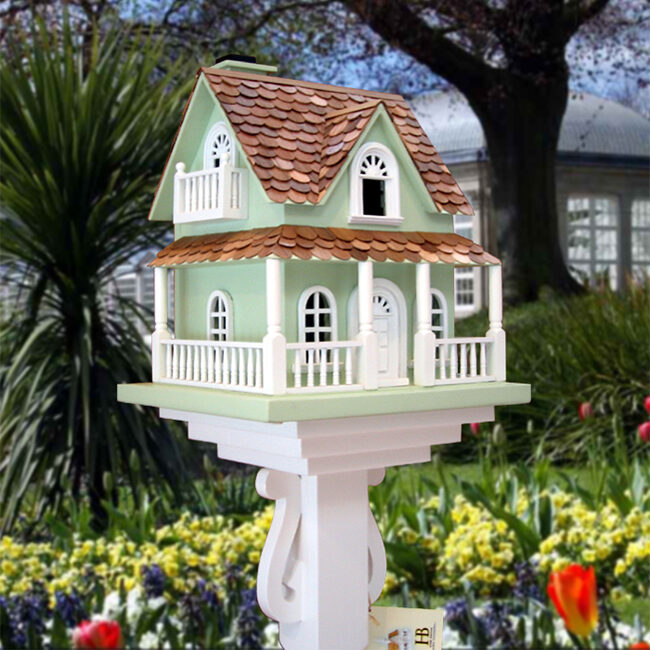As a passionate bird enthusiast and garden lover, I can attest to the joy that comes from incorporating large decorative bird houses into your outdoor space. Not only do they enhance the visual appeal of your garden, but they also provide a welcoming habitat for our feathered friends. In this comprehensive guide, I will share my experiences, insights, and tips on choosing and maintaining the perfect large decorative bird house for your garden.
Why Choose Large Decorative Bird Houses?
Large decorative bird houses serve multiple purposes, making them a worthwhile investment for any garden. Here are some compelling reasons to consider:
- Attract Bird Species: Larger bird houses can accommodate various bird species, including bluebirds, wrens, and chickadees.
- Garden Aesthetics: These structures add charm and personality to your garden, transforming it into a magical retreat.
- Educational Opportunities: Birdwatching can be a fantastic educational experience for children and adults alike.
The Ideal Location for Your Bird House
Choosing the right location for your large decorative bird house is crucial for its effectiveness. Here are some factors to consider:
Sunlight and Shade
Birds prefer a mix of sunlight and shade. Ensure your bird house is not placed in direct sunlight all day, as this can make it too hot for the inhabitants.

Height and Accessibility
Position your bird house at least 5-10 feet off the ground to protect it from predators while ensuring it is accessible for cleaning and monitoring.
Proximity to Food and Water Sources
Place your bird house near feeders or water sources to attract birds. This will encourage them to visit frequently.

Popular Designs of Large Decorative Bird Houses
There is a wide variety of designs available for large decorative bird houses. Here are some popular styles that are aesthetically pleasing and practical:
Cottage Style
The cottage-style bird house features whimsical architectural elements such as steep roofs and intricate details. They often have vibrant colors that can brighten up your garden.

Victorian Style
With elegant designs and ornate details, Victorian-style bird houses can serve as a stunning focal point in your garden.
Rustic Style
Rustic bird houses made from reclaimed wood fit seamlessly into natural garden settings and attract a variety of bird species.

Modern Minimalist
If you prefer a clean, contemporary look, consider a modern minimalist bird house characterized by simple lines and neutral colors.
Materials to Consider for Large Decorative Bird Houses
The materials used in constructing your bird house will significantly impact its durability and maintenance. Here’s a comparison of common materials:
| Material | Durability | Maintenance | Price |
|---|---|---|---|
| Wood | Very Durable | Requires regular treatment | Moderate |
| Metal | Highly Durable | Minimal maintenance | Higher |
| Plastic | Durable | Easy to clean | Lower |
Pros and Cons of Large Decorative Bird Houses
Every garden element comes with its own set of advantages and disadvantages. Here’s a quick overview:

Pros
- Enhances garden aesthetics
- Provides shelter for birds
- Encourages biodiversity
- Creates an engaging hobby
Cons
- Requires maintenance and cleaning
- Potential cost depending on materials and design
- May attract unwanted pests
Setting Up Your Large Decorative Bird House
Once you’ve selected the perfect bird house, follow these steps to set it up correctly:
- Choose a Location: Find an ideal spot based on the factors discussed earlier.
- Install Safely: Use screws or sturdy nails to secure the bird house. It should be stable and resistant to harsh weather conditions.
- Provide Nesting Materials: Consider adding natural materials such as straw or dried grass to encourage nesting.
Maintenance Tips for Large Decorative Bird Houses
Keeping your bird house in good condition is vital for attracting and retaining birds. Here are some maintenance tips:
Regular Cleaning
After the nesting season, clean the bird house thoroughly to remove old nesting material and prevent parasites.
Check for Repairs
Inspect your bird house regularly for any signs of damage. Replace any broken parts immediately.
Seasonal Updates
Consider adding new decorations to your birdhouse at the start of every season to keep it visually appealing.
Conclusion
Large decorative bird houses are a beautiful and functional addition to any garden. By choosing the right design, materials, and location, you can create a welcoming environment for birds that will bring joy to your outdoor space. With proper maintenance, your bird house will serve as both an aesthetic focal point and a natural habitat for years to come. Happy birdwatching!
FAQs about Large Decorative Bird Houses
What birds can I attract with large decorative bird houses?
You can attract a variety of birds, including bluebirds, wrens, chickadees, and even some swallows, depending on the design and size of your bird house.
How often should I clean my bird house?
It’s best to clean the bird house at least once a year, preferably after the nesting season, to remove old nesting materials and ensure a healthy environment for new occupants.
Are decorative bird houses durable?
Yes, decorative bird houses can be very durable if made from quality materials. Wood, metal, and high-quality plastic can withstand the elements when properly maintained.
Can I paint my bird house?
Absolutely! Just ensure you use non-toxic paints that are safe for birds. Light colors are preferred to reflect sunlight.
Do I need to use any special features in my bird house?
Features like ventilation holes, drainage holes, and proper entrance sizes can improve the conditions within the bird house and make it more appealing for birds.